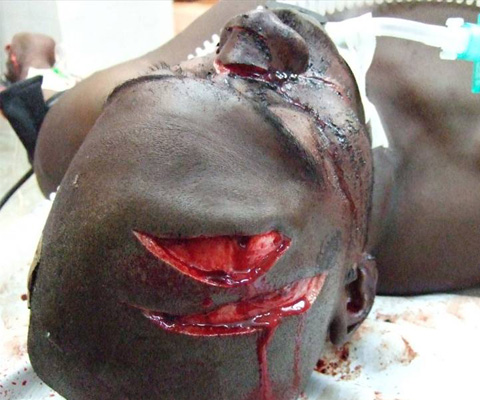General Management
General management priorities for head injured patients are:
- Airway with cervical spine control
- Breathing
- Circulation and haemorrhage control
Preventing hypoxia and hypotension minimizes secondary brain injury.
In patients with both bleeding and head injury, stopping the bleeding takes priority. Once bleeding is controlled, hypotension should be corrected.
Diagnosis and treatment of intracranial bleeding depends on the facilities available.
All patients should have basic medical management and supportive care.
Conscious level should be monitored and deterioration acted upon.
Select the Surgical Management tab to continue.

Surgical Management
Surgical management priorities for head injured patients are:
- All patients with reduced conscious level should have an urgent CT scan if available. Extradural and subdural haematomas need urgent surgery
- Patients requiring transfer or CT scan must be stabilised without delay. This is explained on the next page
- If CT scanning and neurosurgery are not available, burr hole decompressions may be lifesaving for extradural or subdural haematoma
- The indications for burr holes are:
- A history of trauma with rapid deterioration in conscious level
- Lateralising signs: weakness on the opposite side and dilating pupil on the same side as the injury
- Patients with severe head injuries (GCS <9) should be managed medically. This is explained on the next page.
Even those with no indication for surgery may recover.
Select the Medical Management tab to continue.

Medical Management
Patients with GCS< 9 should be intubated and ventilated. This allows airway protection, control of PaCO2 (4.5-5 KPa) and sedation. However, this requires a ventilator, CO2 monitoring, infusion pumps and BP monitoring.
If these are not available: give oxygen, use a guedel airway if required and place an orogastric tube; consider nursing on their side (this compromises cervical spine immobilization but may help prevent aspiration).
Blood pressure should be normal or high. Head injures do not cause hypotension in adults; look for other causes. Treat any bleeding first, then give IV fluids (0.9% saline) but avoid fluid overload. Monitor fluid balance and urine output.
Nurse 20 degrees head up, prevent hyperthermia (cool) and monitor blood glucose. Treat seizures with phenytoin. Turn regularly to prevent pressure sores.
Consider feeding through an orogastric tube (or nasogastric if base of skull fracture has been excluded).
Ideally, the cervical spine should be fully immobilised until the patient is conscious or a CT scan is available. This may not be possible. Use a padded hard collar, e.g. Miami J/Aspen/Philadelphia, if available and check under the collar regularly for pressure sores. Turning from side to side will be required to prevent pressure sores and sitting the patient up may help breathing and reduce the risk or aspiration. If immobilisation is causing problems, removing it should be a team decision involving senior clinicians.
